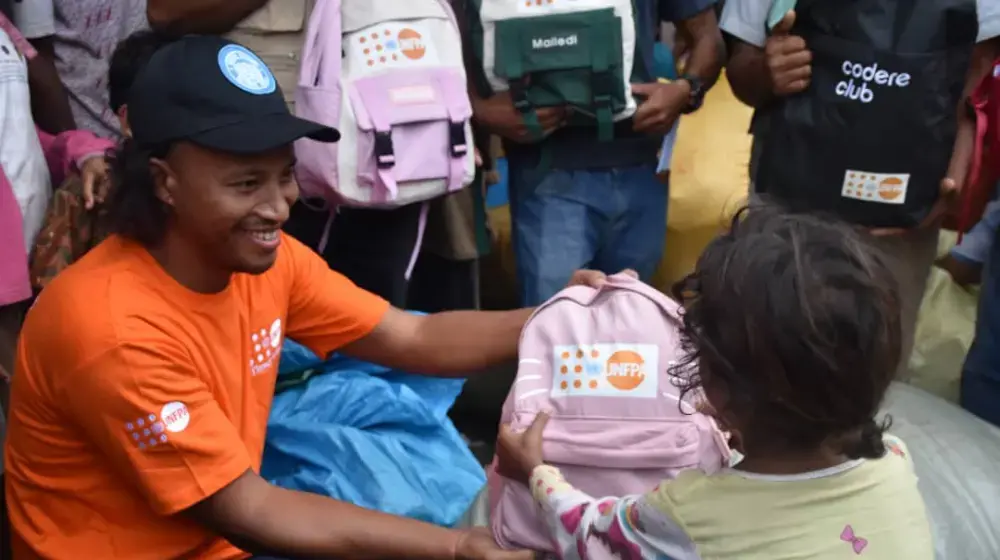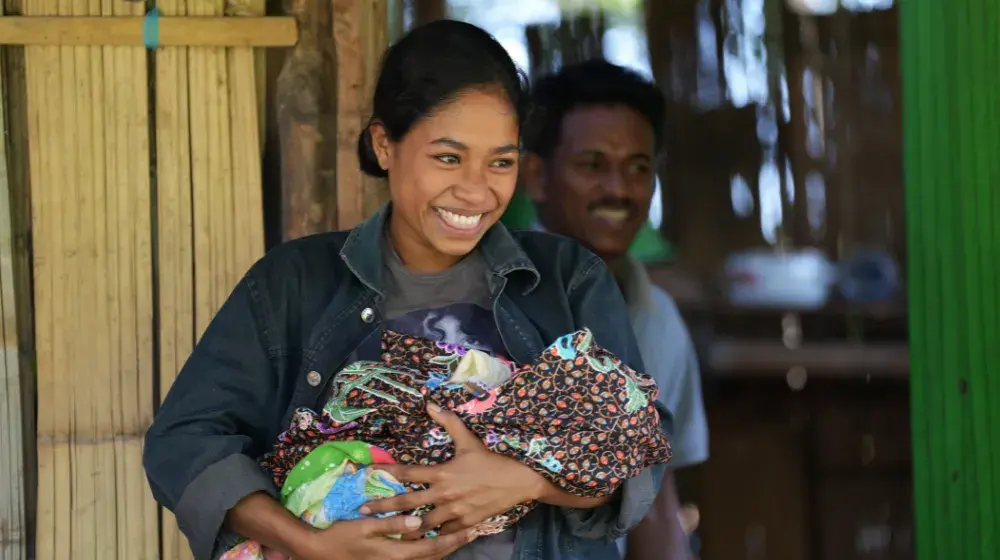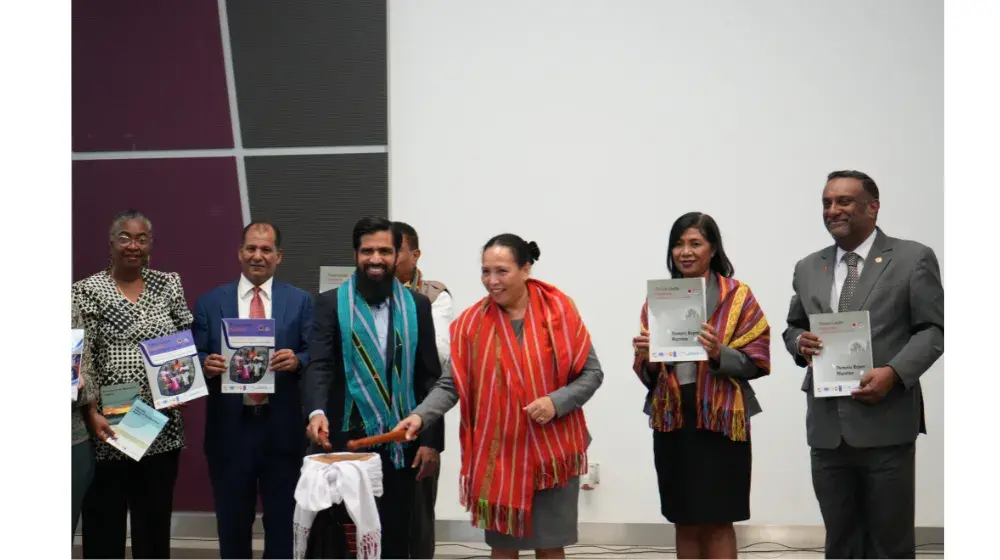Take a moment to imagine a 10-year-old girl right now. What do you see? Is she in school? Is she laughing with friends? Do you imagine her riding a bike or playing ball? On roller skates or en pointe in ballet class? With her nose in a book or her eyes on a chess board?
Or perhaps you imagined a different scene, one that still plays out daily in many parts of the world: a girl who wakes up in the morning and finds out that she'll be married that afternoon and taken out of school forever, a girl who will be forced to start bearing children as soon as her body allows it, and will stop being a child and start being a labourer in the home.
This is the tragic reality for millions of 10-year-old girls as they approach puberty.
While in some places, age 10 can be a time of exploration, expanding horizons and new possibilities, in others it can be a time where barriers emerge, limiting options, choices and opportunities.
Many girls are transformed from children with rights and aspirations, into brides, free labour or objects of exploitation-forever excluded from decisions about their lives and blocked from realizing their full potential.
This is a grave and unforgivable injustice and a violation of girls' fundamental rights. And whenever a girl's future is derailed in this way, her household, community and nation also suffer. With no freedom to make choices, get an education and find a good job, she will never have the power to participate in the affairs of her community and contribute to her country's development.
But when a girl is protected from child marriage, is able to stay in school and make her own decisions about whether or when to become pregnant, the potential gains to her--and her society--are huge.
Each extra year a girl stays in high school, for example, delivers an 11.6 per cent increase in her average annual wage for the rest of her life. In India alone, there are over 12 million 10-year-old girls of whom nearly 900,000 will not move from primary to secondary school this year. If half of those 900,000 girls finished secondary school and later got a job, they could together earn almost $2 million over the next 15 years.
In fact, if all the 10-year-old girls living in developing countries today were able to finish high school and make their own decisions about marriage and parenthood, they would together earn an estimated $21 billion by the time they reach 25.
In most developing and middle-income countries, a girl who stays in school, gets a job and delays pregnancy will earn up to three times as much in her lifetime as her counterpart who does not finish high school and becomes pregnant as an adolescent.
And research has shown that a girl who makes a safe and healthy transition through adolescence to adulthood has higher status in her household and community and invests earnings back into her household, setting in motion a virtuous cycle of social and economic empowerment that can last for generations.
The benefits of keeping a 10-year-old girl's life on track are indisputably large.
According to The State of World Population 2016, published today by UNFPA, the United Nations Population Fund, keeping every 10-year-old girl's life on track is possible, but it requires support from, and investments by, everyone around her-her family, community and government. Men and boys also have a critical role in tearing down the barriers that prevent girls from realizing their full potential.
So what can be done?
First, end all practices that harm girls. This means, for example, enacting and enforcing laws that prohibit child marriage.
Second, enable girls to stay in school, at least through high school. Study after study has shown the longer a girl stays in school, the less likely she is to become pregnant as an adolescent and the more likely to grow up healthy and join the paid labour force.
Third, provide extra support to marginalized and impoverished girls who have traditionally been left behind.
Make sure girls, before they reach puberty, have access to information about their bodies. Later in adolescence, they need information and services to protect themselves from unintended pregnancy and sexually transmitted infections, including HIV.
And above all, take steps to protect girls' - and everyone's - rights.
We have every reason to prioritize the development of every girl's capabilities. Our collective future depends on it.
Today's 60 million 10-year-old girls will be 24 when progress towards the United Nations' new development agenda is tallied in 2030.
That agenda aims for inclusive, equitable and sustainable development that leaves no one behind. The real test of its success will be whether every 10-year-old girl today will be healthy, educated and productive in 2030.
The world cannot afford to squander the potential of even one more girl. Instead, we must do everything in our power to ignite that potential-for her sake and for the sake of us all.
***
Dr. Babatunde Osotimehin is a United Nations Under-Secretary-General and Executive Director of UNFPA, the United Nations Population Fund.
Tetum Version
Tamba sa ita nia futuru depende ba labarik feto ida ho idade tinan 10
Husi Dr. Babatunde Osotimehin
Foti minutu balu atu imajina labarik feto ida ho idade tinan 10 agora dadaun. Saida maka ita hare? Nia iha eskola k? Nia hamnasa ho nia kolega? Ita imajina nia sae hela bisikleta ka halimar bola? Ho sapatu rod ka iha aula ballerina? Ho nia inus iha livru ka matan iha kuadru eskola?
Ou dalaruma ita imajina senariu nebe diferente, labarik feto ida nebe iha nasaun balu: labarik feto ida nebe hader mai no hakfodak nia atu kaben iha lokraik no sai husi eskola permanente, labarik feto ida nebe hetan obriga atu iha oan bainhira nia isin seidauk prountu, no nia para kedas ho nia moris hanesan labarik no hahu halo servisu uma loron-loron nian.
Ida nee maka realidade trajiku nebe akontense ba labarik milhaun ho idade tinan 10 bainhira sira tama dadaun ba periudu puberdade.
Bainhira iha fatin balu, idade tinan 10 maka tempu nebe atu explora, habelar liu tan oportunidade no posibilidade foun, iha parte seluk mos bele sai hanesan tempu iha nebe mosu obstaklus, hamenus opsaun, no desijaun no oportunidade sira.
Labarik feto barak maka transforma husi periudu labarik ho direitu ho aspiraaun, sai feto kaben nain, servisu la hetan salariu ka objeitu ba exploitasaun- sira la involve permanente hodi foti desizaun kona-ba sira nia moris no taka dalan ba sira atu realiza sira nia potensialidade.
Ida nee sai hanesan buat ida nebe aat no injustisa nebe labele perdua no violasaun ba direitus fundamental labarik feto sira nian. No iha nebe labarik feto sira nia futuru sai ladiak, nia uma laran, komunidade no nasaun mos sofre. Bainhira labarik feto ida la livre atu halo desizaun, hetan edukasaun no buka servisu, nia nunka iha poder atu partisipata iha atividade iha nia komunidade no kontribuia ba dezenvolvimentu nasaun nian.
Maibe bainhira labarik feto ida proteje husi kaben ho idade sedu, nia sei iha oportunidade hela iha eskola no foti desijaun ba nia aan rasik kona-ba oinsa no bainhira maka isin-rua, no ida nee sei lori potensialidade boot ba nia no nia sosidade rasik.
Ezemplu kada tinan labarik feto ida hela iha eskola sekundaria, sei kontribui ba pursentu 11.6 iha ninia taxa anualmente durante nia moris tomak. Iha nasaun India deit, liu milhaun 12 labarik feto ho idade 10 nebe maka besik 900,000 sei la tama ba iha edukasaun sekundaria iha tinan ida nee. Karik metade husi 900,000 labarik feto sira nee remata sira nia eskola sekundaria no depois hetan servisu, sira bele ganha liu milhaun $2 iha tinan 15 oin mai.
Iha realidade, karik labarik feto sira hotu idade tinan 10 hela iha nasaun nebe sei dezenvolve hela sei bele remata sira nia eskola sekundaria no foti desijaun kona-ba kazamentu no sai inan-aman, sira sei bele ganha maizumenus $12 bilaun bainhira sira tama idade 25.
Maioria iha nasaun nebe sei dezenvolve hela no nasaun hirak nebe maka ho ekonomia media iha nebe labarik feto ida bele kontinua nia eskola, hetan servisu no atraza isin-rua sei ganha dala tolu barak liu durante nia moris tomak hanesan no nia kolega sira nebe maka la remata sira nia eskola sekundaria no hetan isin-rua durante tempu adolesente.
No peskija hatudu labarik feto ida nebe maka halo transizaun ba adolesente no jovem ho seguru no saudavel hetan apresiasaun ba nia estadu nebe aaas liu iha nia uma-laran no komunidade no sei investe fila fali ba nia uma laran, hatudu mos mosaun iha siklu sosial no empoderamentu nebe bele kontinua ba jerasaun sira tuir mai.
Benefisiu atu tau atensaun ba labarik feto idade 10 nia moris kontribui ba benefisiu nebe labele sura.
Tuir relatoiru Estadu Mundial Populasaun 2016, nebe publika husi UNFPA, bainhira ita fo atensaun ba moris labarik feto ida idade tinan 10 karik posile, maibe presiza suporta husi, nia familia, komunidade no governu. Mane no labarik mane sira mos iha papel importante atu hapara bareira nebe prevene labarik feto sira atu realiza sira nia potensialidade.
Saida maka ita bele halo?
Primeiru: hapara pratika hotu nebe ameasa labarik feto sira. Ezemplu, produz no haforsa lei hapara kaben ho idade kiik.
Segundu, ajuda labarik feto sira hela iha eskola, to'o nivel sekundaria. Kontinua eskola nafatin hatudu katak bainhira labarik feto ida kontinua eskola to'o nivel sekundaria nia sei la isin-rua durante iha tempu adolesente no sei kontinua moris ho saudavel no pronto atu tama ba iha servisu..
Terseiru, fo suporta extra ba labarik feto sira nebe marjilinadu no labarik feto nebe la hetan oportunidade nebe haluha tiha.
Garantia labarik feto sira, antes sira tama idade puberdade, iha asesu ba informasaun kona-ba sira nia isin lolon. Depois adolesente, sira presiza informasaun no servisu sira atu proteje sira nia aan husi isin-rua nebe la hakarak no infeksaun moras hadaet liu husi relasaun seksual, inklui HIV.
No husi aksaun sira nee hotu, foti aksaun atu proteje labarik feto sira nia direitu- no ema idak-idak nia direitu.
Ita iha razaun idak-idak atu prioritiza kona-ba dezenvolvimentu kapasidade labarik feto idak-idak nian. Buat hirak nee depende ba ita nia aksaun hamutuk ba futuru nian.
Ohin loron hamutuk milhaun 60 labarik feto ho idade tinan 10 sei tama ba idade 24 bainhira Ajenda Foun Nasoens Unidas ba Dezenvolvimentu 2030 sei remata.
Ida nee signifika katak dezenvolvimentu ida nebe inklusivu, hanesan no kontinuadu la husik ema ida. Realidade ba susesu ida nee maka kada labarik feto idade tinan 10 ohin loron sei moris saudavel, edukadu no produtivu iha tinan 2030.
Mundu sei labele lakon potensialidade husi kada labarik feto ida. Maibe, ita presija halo buat hotu hoi ta nia poder tomak hodi bele realiza potensialidade ida nee-ba labarik feto nia diak no ita hotu hotu nia diak.
***
Dr. Babatunde Osotimehin maka Sekretariu Jeral no Direitor Ezekutivu FNUP, Fundus Nasoens Unidas ba Populasaun.




